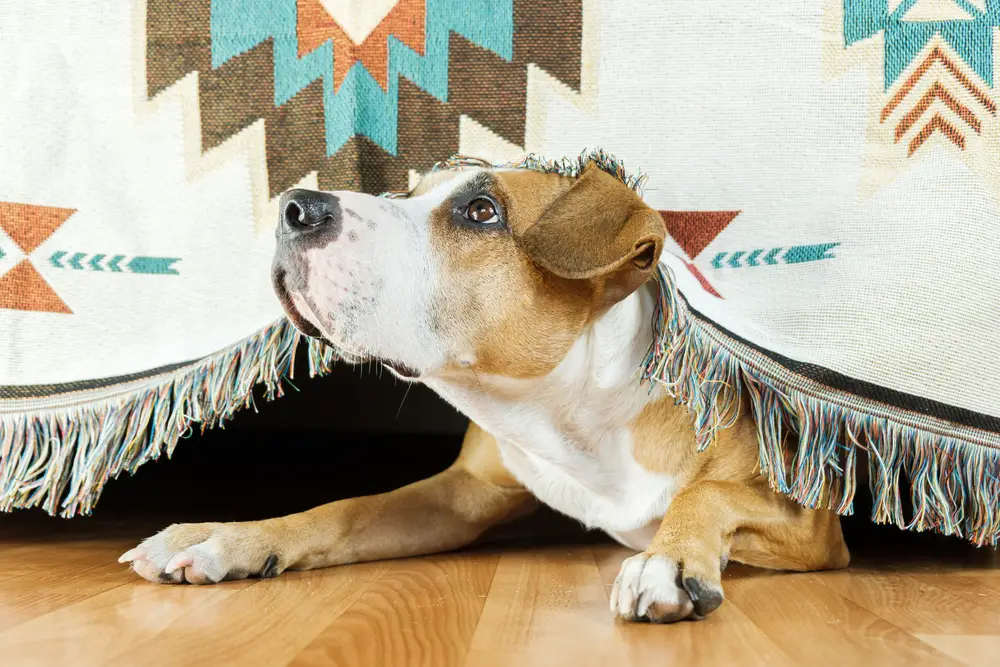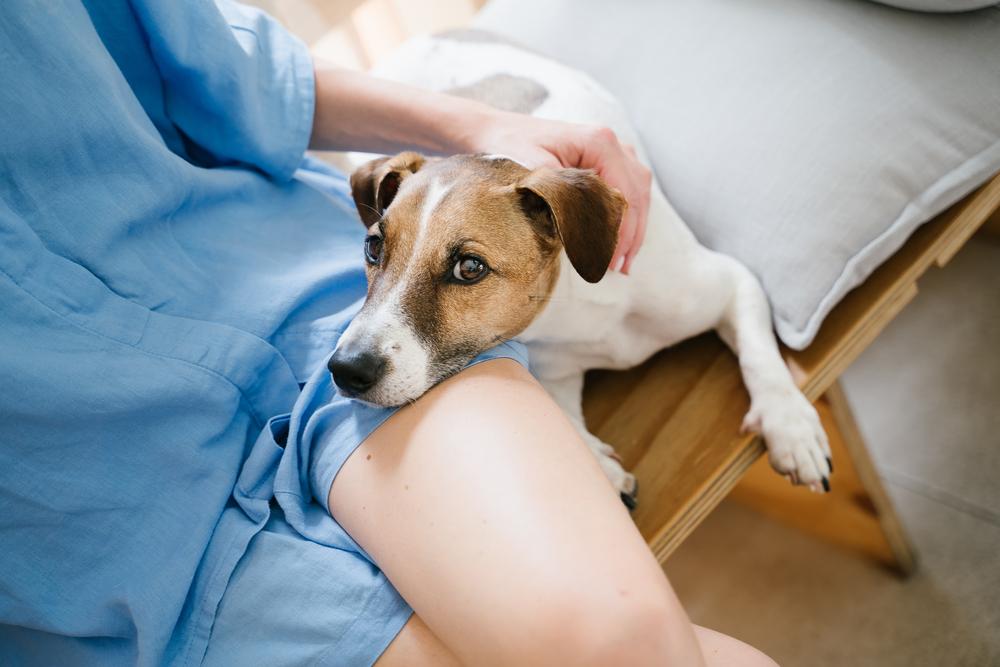As a BetterHelp affiliate, we receive compensation from BetterHelp if you purchase products or services through the links provided
When you notice your dog’s tail isn’t wagging quite as much as it used to or they’re treating the mailman like their arch-nemesis, you might wonder if your furry friend is going through more than just a rough day. Anxiety in dogs can look like an epic saga of nervous tail-tucking or your couch becoming the unwilling victim of a clawing frenzy. If your pooch is pacing more than they’re prancing, it’s time to look closer at what’s happening in their fuzzy little heads.
Like us, dogs can get jitterbugs over various things, from the sound of fireworks to the absence of their human pals. Recognizing canine anxiety isn’t just about tallying up shredded shoes or counting how many times they’ve howled a canine cover of the blues. It’s about tuning into behavioral cues and considering how changes in their environment might be throwing them a psychological curveball.
Before you both spiral into a furball of worry, take a deep breath and reach for the leash of knowledge. There are quizzes and strategies galore to help you navigate the rough waters of pet anxiety. With a sniff of detective work and a pawful of patience, you’ll get to the bottom of your dog’s woes and make their world less woof-some.
Key Takeaways
- Anxiety in dogs can manifest through changes in behavior and reactions to environmental stress.
- Understanding and recognizing symptoms are the first steps toward helping your dog.
- Using quizzes and professional resources can guide you in creating a calming environment for your anxious pup.
 Recognizing Canine Anxiety
Recognizing Canine Anxiety
Before you become a Sherlock Bones in diagnosing your dog’s nervous ticks, remember that dogs, like humans, express anxiety in various ways. Figuring out if your furry friend is stressed can be as tricky as a dog trying to catch its own tail, but by recognizing certain behaviors, you’ll be one paw closer to helping your pup find peace.
Hounding Signs of Nervousness
Your dog may not have a poker face when it comes to anxiety. Watch out for:
- Panting and pacing: Even when it’s not hot, your dog might pant more than a marathon runner if they’re stressed.
- Shivering or trembling: This could be a sign they’re not just cold but also anxious.
- Hiding or tucking the tail: If they’re trying to become invisible behind the couch, it’s a sign they’re not feeling top dog.
Key takeaway: If your pooch is panting without an exercise session or prefers the solitude of under-the-bed darkness, they might signal SOS in doggy language.
Barks and Whines: Vocal Cues
When your dog sounds off, it’s not always an aria for the neighborhood:
- Excessive barking or howling: A dog’s bark is their voice, and constant yapping might mean they feel strain.
- Whining or whimpering: These soft noises can be your pooch admitting, “I’m feeling ruff.”
Key takeaway: Next time your dog holds a barking marathon, it might not be about the mailman but an SOS on their emotional state.
Reading Paws-itive Body Language
Sometimes actions speak louder than barks:
- Excessive licking or chewing: Your dog might try to self-soothe faster than licking a double-scoop ice cream cone on a summer day.
- Avoidant behavior: Dodging cuddles like they’re negotiating an obstacle course might hint they’re stressed.
Key takeaway: Spotting anxiety through body language is about noticing your furball’s slick lick trick or their sudden shyness at snuggle time.
Why Dogs Get the Woof-Jitters
Dog anxiety isn’t just a bunch of hocus-pocus; it’s as real as the drool on your favorite slippers. Your pup can exhibit worry-wags for a few tail-twitching reasons.
Separation Sadness: Attachment Issues
Attachment Issues
You know the drill: you grab your keys, and your furry friend starts the panic pant. That’s separation anxiety. It stems from a profoundly dogged need to be with their human pack.
- Symptoms: Non-stop barking, destructive chewing, or indoor accidents.
- Breed Note: Some breeds, like Labradors and German Shepherds, might stick to you closer than a burr on a sock.
Key Takeaway: If your pup’s got a case of the sad-paws when you leave, it’s a classic sign of separation anxiety.
Genetic Predisposition
It’s in the Genes
Like you might inherit your grandpappy’s nose, some dogs inherit the worry-warts from their doggy ancestors.
- Aging Factor: Age can also bring about anxiety as senior dogs might confuse the old-timers.
- Symptoms: Nervous tail-chasing or excessive licking could be clues.
Key Takeaway: You can thank Rover’s family tree for some of those nail-biting habits.
Loud Noises and Phobias
Sound the Alarm!
Boom, bang, and kaboom! Loud noises can turn your brave pooch into a quivering furball.
- Fear Triggers: Thunderstorms and fireworks are the usual suspects.
- Symptoms: Hiding away or shaking like a leaf on a windy day can indicate a noise phobia.
Key Takeaway: Your dog might not appreciate the Fourth of July fireworks as you do; they could be phobia-inducing loud noises for them.
 Tackling the Tailspin
Tackling the Tailspin
Navigating your dog’s anxiety is a bit like decoding a howl in the wind: tricky but not impossible. Equip yourself with the right strategies, starting with a visit to the expert tail-waggers doctor—a veterinarian.
Veterinarian Visits are Pawsome
First things first, schedule a check-up with your vet. They’ll sniff out whether your pup’s jitters are due to an underlying health issue or just plain old anxiety.
- Key Takeaway: Popping into the vet’s office could lead to a health-based solution for your furry pal’s nerves.
Behavior Training: Rolling Over Anxiety
Training’s not just about teaching your dog to fetch; it’s also about fetching your dog’s peace of mind.
- Positive Reinforcement: Reward your dog for calm behavior to reinforce that chill is the new thrill.
- Desensitization: Gradually introduce the source of anxiety in a controlled way so your dog learns to say, “Been there, sniffed that.”
- Counterconditioning: Pair the scary thing with a treat; suddenly, that vacuum cleaner isn’t looking so monstrous.
- Key Takeaway: Consistency with training is your golden ticket to a more relaxed pup.
Crate Training Comforts
When done right, a crate is not a jail but a zen den for your anxious pooch.
- Ensure the crate is cozy, with a soft blanket and their beloved chew toy.
- Gradually increase their crate time so they know it’s a safe space, not a time-out corner.
- Key Takeaway: Think of crate training as crafting a spa for your barky buddy.
Medicine and Mutt-calming Methods
Sometimes, a little medical intervention is the wag to go alongside behavior modification.
- Medication: In consultation with your vet, anxiety meds may help take the edge off.
- Coping Strategies: Introduce calming aids like pheromone diffusers or anxiety wraps.
- Key Takeaway: A combo of medication and soothing strategies can turn the volume down on your dog’s worry woofs.
 Home Sweet Bone: Creating an Anxiety-Free Environment
Home Sweet Bone: Creating an Anxiety-Free Environment
In your quest to banish those puppy jitters, transforming your home into a zen den for your furry friend couldn’t be more crucial.
Toys and Distractions: Marvelous or Misleading?
Think of toys as the canine version of bubble wrap — immensely satisfying and a bit addictive. Yet, not all dog toys are created equal when combating anxiety.
- Chew Toys: Great for stress relief, keep those jaws busy and minds off the boogeyman.
- Interactive Toys: Brain games to the rescue! Puzzles can tire out your pooch’s noggin and keep panic at bay.
Key takeaway: Match the toy to your dog’s anxiety. If Spot shakes like a leaf during thunderstorms, a soothing chew toy might be his best thunder buddy.
Setting the Stage for Serenity
Your home should be a fortress of solitude for your anxious pup; fortify it with love and a touch of strategy.
- Comfy Den: A plush dog bed in a quiet corner can be a haven.
- Familiar Scents: Your worn T-shirt has superpowers; who knew? It smells like you and can be a comforting nuzzle buddy when you’re away.
Key takeaway: Comfort is king. Your scent is the secret sauce in making your pup feel wrapped in a warm hug.
Exercise: Paws and Reflect
Never underestimate the power of a good leg stretch. Regular exercise isn’t just for keeping those furry glutes in shape; it spells ‘zen’ in the doggo language.
- Daily Walks: Dust off that leash and hit the pavement; fresh air is the magic potion for anxiety.
- Play Time: Backyard fetch or tug-of-war? Both are fabulous at whittling down those nerves into non-existence.
Key takeaway: Tuckered-out dogs are happy dogs. After a good romp, they’ll only be worrying about when dinner’s served.
The Scoop on Poop and Other Anxiety Indicators
Your dog might just be giving you a sign, not seeking applause for their latest indoor performance. When they feel like the world is a bit too much, their behavior could turn towards the destructive side, or their bathroom habits might become a little less predictable. Let’s unpack these behaviors, shall we?
Chew on This: Destructive Habits
When your four-legged bestie starts auditioning for a spot in the “Dogs Gone Wild” series by gnawing on your favorite pair of shoes, it might not just be for the taste of Italian leather. Watch out for:
- Chewing: More than a dental exercise, it’s often a cry for help. Are toys, cushions, or personal items turning into debris? That’s a red flag.
- Destructive Behavior: If your door frames look more like modern art than part of your home structure, your pooch could be stressed.
Key Takeaway: A chewed-up spatula isn’t the new trend in kitchenware; it’s a sign your pup could be anxious.
Accidents Happen: Stress-Induced Responses
Even house-trained dogs can have a whoopsie when their stress levels hit the roof. Keep an eye out for:
- Urinating: Sudden indoor puddles? Your doggo might say, “I’m anxious,” louder than a splash in a quiet pond.
- Diarrhea: Stress can stir the pot in their stomachs, leading to less-than-ideal poop scenarios. If your dog’s poop is more abstract expressionism than solid form, it’s a sign.
Key Takeaway: If your pup suddenly forgets their bathroom manners, it could mean they’re feeling more worried.
Furry Friends and Professional Pals: Seeking External Help
When your furry buddy seems to be fretting more than fetching, it might be time to call in some reinforcements. Anxiety in dogs can be as complicated as rush hour traffic, but lucky for you; professional help is just a leash-length away!
Dog Whisperers and Canine Therapists
Meet the unsung heroes who speak bark-nese better than you know your ABCs. These trained professionals are ready to guide your pup through stress with a mix of training strategies that are more effective than a belly rub on a bad day.
- Strategies they may use:
- Positive reinforcement
- Desensitization exercises
- Cognitive-behavioral hacks
They come armed with treats and an understanding of doggy dialect that can unveil what’s making your pooch pace. They often work as translators for a game of “What’s bothering the Beast,” and they’re pretty good at it.
Key Takeaway: Your dog’s anxiety might need a chat in woof-ese, and these therapists are the go-to for translating and training.
Veterinary Behaviorists to the Rescue
You might need a veterinary behaviorist if your dog is doodling doom and gloom instead of chasing their tail. These are not your average vets; they’re like the super vets with extra training in animal behavior and a toolkit that includes medications to help your pup feel paws-itive again.
- What they offer:
- Diagnosis of behavioral issues
- Tailored treatment plans involving medications if necessary
- Follow-up care and assessment
They’re the pill-dispensing, behavior-diagnosing wizards who can prescribe a chill pill (quite literally) to soothe your canine’s nerves if training alone doesn’t do the trick.
Key Takeaway: When your pup’s problems are tough to crack, a veterinary behaviorist has the magic potion (and the medical degree) to dial down the drama.
DIY Doggie Zen: Anxiety Quizzes and Self-Help
Your four-legged friend’s tail wags might be saying more than just “happy to see you.” Let’s sniff out if your pup’s occasional whimper is a case of the jitters or something more.
Anxiety Quiz: Is Your Dog a Nervous Barker?
Symptoms Checklist:
- Excessive barking at butterflies or even their own shadow.
- Chewing on shoes – and not just for the leather flavor.
- As social as a lone wolf at parties.
How’d your pooch score? If you ticked off more boxes than you have fingers, it might be time to consider if your dog is dealing with anxiety.
Key Takeaway: A little checklist goes a long way in understanding if your dog’s barks are nerves talking.
Is My Pooch a Nervous Nellie? – A Light-Hearted Quiz to Sniff Out Canine Anxiety
Ever wondered if your dog’s quirky behaviors are just that or signs of something more? It’s time to play detective in the mystery of your dog’s mood swings. Let’s embark on a fun, tongue-in-cheek journey to uncover whether your four-legged friend is just having a ruff day or if they’re sending SOS barks for help!
- The Mailman Chronicles:
- Does your dog treat the mailman like a) A long-lost friend? b) Just another human? c) The villain in every dog movie ever made?
- The Firework Fiasco:
- When fireworks pop: a) Is your dog unfazed and dreaming of bones? b) Slightly curious but mostly chill? c) Plotting an escape to a faraway, quiet planet?
- Couch Catastrophe:
- Your couch’s current state: a) Pristine, like it’s just from a doggy decor magazine? b) Light wear and tear, a few dog hairs here and there? c) It looks like it survived a canine zombie apocalypse.
- Tail Tales:
- Your dog’s tail wagging is: a) Like a metronome at a happy beat? b) Depends on the day and the mood? c) Only seen in historical footage?
- Home Alone: Dog Edition:
- When you’re away, your dog: a) Throws a solo party with their toys? b) Takes a snooze fest? c) Holds auditions for the next doggy opera?
- Pacing or Prancing?:
- Your dog’s walking style is more: a) A graceful prance like a furry ballerina? b) A casual stroll, stopping to sniff occasionally? c) A marathon pace, like they’re training for the Dog Olympics?
Results:
- Mostly As: Congrats! Your dog seems like a chill furball, taking life one tail wag at a time.
- Mostly Bs: Your pup might have moments, but they handle stress like a pro.
- Mostly Cs: Ding Ding! We might have a case of the jitters here. It might be time to dive deeper into understanding your dog’s anxiety and exploring calming strategies.
Remember, while this quiz is in good fun, always consult a vet or a pet behaviorist for a professional opinion. Every dog is unique, and what might be a quirk for one could be a cry for help for another. Stay pawsitive! ????✨
Implementing Do-It-Yourself Solutions
Behavioral Treatments (aka Doggie DIY Therapy):
- Cool your jets: Create a chill zone with a comfy bed and chillout tunes.
- Game on: Engage in playtime to distract from stressors.
Home Remedies:
- Stuffed Kongs: A puzzle of treats like Sudoku for your dog’s brain.
- Lavender scents: Not just for your spa day, it’s aromatherapy for pups, too!
Remember, these are just the starting blocks to help your dog feel more zen. If your dog could text, they’d probably thank you for trying these out!
Key Takeaway: Every dog’s path to zen is unique, so trial and error might sniff out your dog’s happy place!
Barking Up the Knowledge Tree: Additional Resources
Looking to decode your dog’s anxious antics? You’re in luck! The world is full of insightful resources that can lend a paw in your quest. Here’s a tail-waggingly good list to fetch:
- Books — Snuggle up with titles like The Anxious Dog by Cesar Millan.
- Online articles — Grab your scrolling finger and peruse pieces like “10 Signs Your Dog Might Have Anxiety” on pethealth.com.
- Veterinarians — They’re like doggy detectives, ready to solve the mystery of your pup’s mood swings.
- Local dog trainers have tricks up their sleeves that can teach you and your dog to deal with anxiety.
- Support groups — No need to howl at the moon alone. Chat with fellow pet owners online or in person.
Key Takeaway: Pulling the right resources off the shelf can turn your dog’s frown upside down quicker than it can chew your favorite slippers!
Conclusion: The Pursuit of Paws-itivity
Recognizing anxiety in your furry friend isn’t just about reading the signals — it’s about sniffing out the subtlety. Your pooch might not be able to say, “Hey, I’m stressed out here!” but those tell-tale signs are there if you know where to look. Panting, pacing, and preventive hide-and-seek championships in every nook and cranny is more than just quirky behavior; they’re clues pointing to a pupper in distress.
Treating your dog’s anxiety is like a well-choreographed dance routine: it takes patience, practice, and many treats as incentives. Positive reinforcement is your best friend here. Shower your canine companion with praise and goodies for every small victory over their fears.
- Symptoms to watch for: Excessive barking or howling when alone, destructive behavior, and unexplained restlessness.
- Treatment strategies: Consistent routines, safe spaces, behavior therapy, and sometimes medication — vet-prescribed, of course.
Don’t be fooled; sometimes, the bravest tail waggers need a paw to hold—approach anxiety treatment with a light touch and humor. If your dog’s hiding under the couch, slide-in for a furry huddle. As they say, if you can’t beat them, join them!
Key Takeaway: Remember, anxiety in dogs is no joking matter. But with your loving support, bags full of treats, and a dash of humor, the path to paws-itivity is well within reach. Who knew being your dog’s superhero could be so rewarding?
Frequently Asked Questions
Navigating the quirks and anxieties of your furry companion can often feel like you’re deciphering Morse code. Let’s decode some common signs and questions pet parents have when suspecting their dog of being a bundle of nerves.
What are the tail-tell signs that my pooch is a worrywart?
Your four-legged friend may not have a diary to scribble down their woes, but their body language speaks volumes. If your dog is regularly tucking its tail, avoiding eye contact, or sporting the ‘half-moon eye’, it might be broadcasting its inner turmoil.
Key takeaway: Keep an eye on your dog’s body language; it’s their way of sending you an SOS signal.
Could my dog’s chewed-up shoe collection be a sign of the jitters?
Absolutely, your pup turning your favorite sneakers into a dog’s chew toy might not be just a hobby but a sign of stress. Excessive chewing, particularly when you’re not around, can be your dog’s way of coping with anxiety.
Key takeaway: While a mangled shoe is a fashion faux-pas, it may also be a cry for help from a stressed pooch.
Is my canine buddy just being clingy, or could it be a case of the doggie doldrums?
A velcro dog that won’t leave your side might be more than just a touch affectionate. Clinginess is often a classic hallmark of separation anxiety. If your pup gets antsy when you grab your keys, it’s not just puppy love. It’s likely fretfulness.
Key takeaway: Affection is delightful until it’s a shadow of anxiety; your pup’s clinginess may mean they’re stressed.
Why does my pup freak out during thunderstorms—is it bravery or a ‘bark-out’?
While bravery would be a noble quality, the more likely explanation for your dog’s thunderstorm terror is fear. The crashes and booms are to dogs what a horror movie with surround sound is to you – utterly terrifying.
Key takeaway: Remember, your dog isn’t auditioning for an action-hero role; storms rattle their nerves.
How can I throw my dog a bone to break their nervous spell?
It’s all about creating a zen den and doling out some calm vibes. Establish a safe space with their favorite blanket or toy, and consider background music to muffle scary noises. Consistency and routine can also be as comforting as a belly rub.
Key takeaway: A chilled-out zone and a predictable routine are your secret ingredients in the recipe for canine calm.
What are the tricks to teach an old (or young) dog to chillax?
Start with obedience training; it’s not just a party trick but can boost your dog’s confidence. Then sprinkle in puzzle toys to keep their brain busy and maybe try dog yoga – yes, it’s a thing, and yes, it’s as adorable as it sounds.
Key takeaway: Mix in training and brain games to help your dog find their inner Zen master.
These signs and solutions are the first steps toward understanding and easing your dog’s anxiety. If problems persist, seeking advice from a vet or a professional dog trainer can be just the ticket to soothing your pup’s ruffled fur.
- Breaking the Silence: Why Men’s Mental Health Matters More Than Ever - April 15, 2025
- How to Transform a Home’s Patio Space into a Relaxing Space - March 23, 2025
- 5 Strategies to Use a Cell Phone to Help Manage Your Stress - March 23, 2025
This site contains affiliate links to products. We will receive a commission for purchases made through these links.


 Recognizing Canine Anxiety
Recognizing Canine Anxiety Tackling the Tailspin
Tackling the Tailspin Home Sweet Bone: Creating an Anxiety-Free Environment
Home Sweet Bone: Creating an Anxiety-Free Environment
